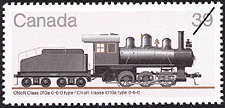CNoR classe 010a type 0-6-0 - 39 cents 1985 - Canadian stamp
Specifications
- Quantity: 9 565 000
- Issue date: November 7, 1985
- Printer: Ashton-Potter Limited
- Scott: #1073
Description
From fond hopes... to a bottomless pit of debt... to consolidation and renewal; that sums up Canadian railroading from 1906 to 1925. The railway craze of the early twentieth century, however, gave Canada no fewer than three transcontinental lines. In 1885, Donald Smith drove the last spike on the CPR. Fifteen years later, an economic boom, the growth of mining, the rapid development of the Prairies, and a spirit of optimism were generating a huge demand for a new railways. Entrepreneurs and politicians eagerly stepped forward to satisfy this demand. William Mackenzie and Donald Mann, for example, had started out as CPR contractor in Western Canada. In 1897 they launched their own 197 km (123-mile) railway in Manitoba. Their system later known as the Canadian Northern, expanded rapidly, especially in the northern Prairies. When Mackenzie and Mann tired of shipping freight to Eastern Canada and the Pacific on rival lines, they developed transcontinental fever. They began work on their transcontinental line after having failed to agree on building on in conjunction with the Grand Trunk, a prominent eastern railway. The Grand Trunk, on the other hand, still wished to enter the market in growing Western Canada. It therefore decided to build a subsidiary - the Grand Trunk Pacific - from Winnipeg to Prince Rupert, and to lease a line that the federal government would construct from Moncton to Winnipeg via Quebec City. Cash and land grants from governments and government guarantees for private bond issues largely paid for the Canadian Northern and the Grand Trunk Pacific. Rising construction costs, economic recession, and war eventually crushed these firms. Private loans for construction dried up. Immigration and its major contributions to the railway business stopped. With initial success, these railways turned for aid to the federal government. However, in 1917 the government began the nationalization process, having concluded that the suppliants would never cease to drain the public purse and that the country's credit rating would suffer if they went under. By 1923, the Canadian Northern, the Grand Trunk Pacific, the Grand Trunk (dragged down by its subsidiary), and several other bankrupt railroads found themselves consolidated into the government-owned Canadian National Railways. The stamps, the third set in the Locomotive series, were designer by Montreal graphic designer Ernst Roch. The meticulously detailed painting of locomotives from this period - A Canadian Pacific P2a, a Canadian Northern 010a, a Grand Trunk K2, a Canadian Government Railways H4D - show the wealth of interesting detail associated with their drive mechanism. The rendering of the engines in a range of greys reflects the drab coloration typical of locomotives of this time period.
Canada Post Corporation. [Postage Stamp Press Release], 1985
Creators
Designed by Ernst Roch
Right now on Ebay (Ad)
Stampsandcanada.com is supported by its audience. When you buy through links on our site, we may earn a commission.
View more »Note
The values on this page are in Canadian dollars (CAD).

